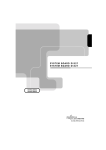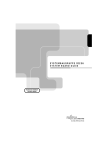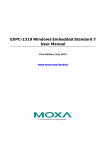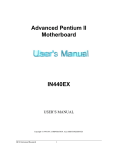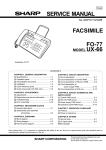Download Fujitsu Siemens Celsius 460 (LKN:FKR-547310
Transcript
SYSTEM BOARD D1192 SYSTEM BOARD D1192 TECHNICAL MANUAL TECHNICAL MANUAL Sie haben ... ... technische Fragen oder Probleme? Wenden Sie sich bitte an: · unsere Hotline: Mo-Fr: 9 - 18 Uhr Sa: 9 - 14 Uhr Tel.: ++49 (0) 180 3777 000 · Ihren zuständigen Vertriebspartner · Ihre Verkaufsstelle Weitere Informationen finden Sie im Handbuch "Sicherheit, Garantie und Ergonomie". Aktuelle Informationen zu unseren Produkten, Tipps, Updates usw. finden Sie imInternet: http://www.fujitsu-siemens.com Are there ... ... any technical problems or other questions you need clarified? Please contact: · your sales partner · your sales outlet You will find further information in the manual "Safety, Guarantee and Ergonomics" . The latest information on our products, tips, updates, etc., can be found on the Internet under: http://www.fujitsu-siemens.com Dieses Handbuch wurde auf Recycling-Papier gedruckt. This manual has been printed on recycled paper. Ce manuel est imprimé sur du papier recyclé. Este manual ha sido impreso sobre papel reciclado. Questo manuale è stato stampato su carta da riciclaggio. Denna handbok är tryckt på recyclingpapper. Dit handboek werd op recycling-papier gedrukt. Herausgegeben von/Published by Fujitsu Siemens Computers GmbH Bestell-Nr./Order No.: A26361-D1192-Z120-2-7419 Printed in the Federal Republic of Germany AG 0900 09/00 A26361-D1192-Z120-1-7419 SYSTEM BOARD D1192 SYSTEM BOARD D1192 TECHNICAL MANUAL TECHNICAL MANUAL Systembaugruppe D1192 System Board D1192 Technisches Handbuch Technical Manual Deutsch English Ausgabe September 2000 September 2000 edition Intel, Pentium und Celeron sind eingetragene Warenzeichen und MMX und OverDrive sind Warenzeichen der Intel Corporation, USA. Microsoft, MS, MS-DOS und Windows sind eingetragene Warenzeichen der Microsoft Corporation. PS/2 und OS/2 Warp sind eingetragene Warenzeichen von International Business Machines, Inc. Magic Packet ist ein eingetragenes Warenzeichen von Advanced Micro Devices, Inc. Rambus, RDRAM, und das Rambus Logo sind eingetragene Warenzeichen der Rambus Inc. Direct Rambus, RIMM, SO-RIMM und Direct RDRAM sind Warenzeichen von Rambus Inc. Alle weiteren genannten Warenzeichen sind Warenzeichen oder eingetragene Warenzeichen der jeweiligen Inhaber und werden als geschützt anerkannt. Copyright Fujitsu Siemens Computers GmbH 2000 Alle Rechte vorbehalten, insbesondere (auch auszugsweise) die der Übersetzung, des Nachdrucks, der Wiedergabe durch Kopieren oder ähnliche Verfahren. Zuwiderhandlungen verpflichten zu Schadenersatz. Alle Rechte vorbehalten, insbesondere für den Fall der Patenterteilung oder GM-Eintragung. Liefermöglichkeiten und technische Änderungen vorbehalten. Dieses Handbuch wurde erstellt von cognitas. Gesellschaft für Technik-Dokumentation mbH www.cognitas.de Intel, Pentium and Celeron are registered trademarks and MMX and OverDrive are trademarks of Intel Corporation, USA. Microsoft, MS, MS-DOS and Windows are registered trademarks of Microsoft Corporation. PS/2 and OS/2 Warp are registered trademarks of International Business Machines, Inc. Magic Packet is a registered trademark of Advanced Micro Devices, Inc. Rambus, RDRAM, and the Rambus Logo are registered trademarks of Rambus Inc. Direct Rambus, RIMM, SO-RIMM, and Direct RDRAM are trademarks of Rambus Inc. All other trademarks referenced are trademarks or registered trademarks of their respective owners, whose protected rights are acknowledged. All rights, including rights of translation, reproduction by printing, copying or similar methods, even of parts are reserved. Offenders will be liable for damages. All rights, including rights created by patent grant or registration of a utility model or design, are reserved. Delivery subject to availability. Right of technical modification reserved. Contents Introduction................................................................................................................................................1 Notational conventions......................................................................................................................1 Important notes..........................................................................................................................................1 Information on boards.......................................................................................................................2 Features.....................................................................................................................................................3 Interfaces and connectors.................................................................................................................5 Temperature monitoring / system monitoring....................................................................................7 Hard disk connection.........................................................................................................................8 LAN port ............................................................................................................................................8 PCI bus interrupts .............................................................................................................................9 Settings with switches and jumpers........................................................................................................10 Recovering System BIOS - switch 2...............................................................................................10 Write protection for floppy disks - switch 3.....................................................................................10 Add-on modules.......................................................................................................................................11 Installing / removing processor.......................................................................................................12 Upgrading main memory.................................................................................................................13 Installing network board with WOL..................................................................................................15 Replacing the lithium battery...........................................................................................................15 Glossary ..................................................................................................................................................16 A26361-D1192-Z120-2-7419 Introduction i Depending on the configuration of your system board, some of the hardware components described may not be available. You may find further information in the description "BIOS Setup". Further information to drivers is provided in the readme files on hard disk or on the supplied drivers diskettes or on the "Drivers & Utilities" or "ServerStart" CD. Notational conventions The meanings of the symbols and fonts used in this manual are as follows: ! i Pay particular attention to texts marked with this symbol. Failure to observe this warning endangers your life, destroys the system, or may lead to loss of data. Supplementary information, remarks and tips follow this symbol. Ê Texts which follow this symbol describe activities that must be performed in the order shown. Ú Ë This symbol means that you must enter a blank space at this point. This symbol means that you must press the Enter key. Texts in this typeface are screen outputs. Texts in this bold typeface are the entries you make via the keyboard. Texts in italics indicate commands or menu items. "Quotation marks" indicate names of chapters and terms that are being emphasized. Important notes Store this manual close to the device. If you pass on the device to third parties, you should also pass on this manual. ! Be sure to read this page carefully and note the information before you open the device. You cannot access the components of the system board without first opening the device. How to dismantle and reassemble the device is described in the Operating Manual accompanying the device. Please note the information provided in the chapter "Safety" in the Operating Manual of the device. Incorrect replacement of the lithium battery may lead to a risk of explosion.It is therefore essential to observe the instructions in the chapter „Add-on modules“ - „Replacing the lithium battery“. A26361-D1192-Z120-2-7419 English - 1 Important notes The shipped version of this board complies with the requirements of the EEC directive 89/336/EEC "Electromagnetic compatibility". Compliance was tested in a typical PC configuration. When installing the board, refer to the specific installation information in the Operating Manual or Technical Manual of the receiving device. Connecting cables for peripherals must be adequately insulated to avoid interference. ! i Components can become very hot during operation.Make sure you do not touch components when making extensions to the system board.There is a danger of burns! The warranty is invalidated if the device is damaged during the installation or replacement of system expansions. Information on which system expansions you can use is available from your sales outlet or the customer service center. Information on boards To prevent damage to the system board or the components and conductors on it, please take great care when you insert or remove boards. Take care above all to ensure that extension boards are slotted in straight without damaging components or conductors on the system board, or any other components, for example EMI spring contacts. Be especially careful with the locking mechanisms (catches, centering pins etc.) when you replace the system board or components on it, for example memory modules or processors. Never use sharp objects (screwdrivers) for leverage. Boards with electrostatic sensitive devices (ESD) are identifiable by the label shown. When you handle boards fitted with ESDs, you must observe the following points under all circumstances: • • • • • 2 - English You must always discharge yourself (e. g. by touching a grounded object) before working. The equipment and tools you use must be free of static charges. Pull out the power plug before inserting or pulling out boards containing ESDs. Always hold boards with ESDs by their edges. Never touch pins or conductors on boards fitted with ESDs. A26361-D1192-Z120-2-7419 Features Features The components and connectors marked are not necessarily present on the system board. • • System board in ATX format PGA 423 Pentium 4 processor with 100 MHz Front Side Bus and 400 MHz data transfer rate. Size and frequency of first-level cache and second-level cache are depending on the processor used. • • • • • • • Intel chipset i850 consisting of ICH 2 Intel 82550 LAN controller (10/100 Mbit/s) with integrated IPSEC accelerator and RJ45 interface WOL with Magic Packet is supported, as is booting from LAN with Bootix LAN BootP or Intel PXE and Basic and Advanced AOL II. AC’97 Audio Codec internal: Stereo CD-In, Stereo AUX-In external: Mono Micro-In, Stereo Line-In, Game/Midi-Port, Stereo Line-Out (max. 2x 0,5 W/8 Ω) Fujitsu Siemens system monitoring and temperature monitoring 4 RIMM slots for 128 to 2 Gbyte main memory (RIMM PC800 or PC600)Only 1-32 RDRAM are supported per RAMBUS channel. Flash BIOS Energy saving functions: − − − − − − − − • Security functions: − − − − − − • • • ACPI S3 / Save-to-RAM (requires an operating system that supports ACPI). ACPI S4 / Save-to-Disk (requires an operating system that supports ACPI). Switching on/off, standby mode, suspend mode via on/off switch Switching on/off via software Wake on RTC Wake on Serial Port 1 Wake on LAN Wake on PCI Cards Cover monitoring: The cover monitoring reports when the cover has been opened without authorization. Chipcard reader interface System, Setup and Keyboard password parallel and serial ports can be deactivated Floppy disk write-protection Virus protection function for the flash BIOS and the EEPROMs on the memory modules 5 PCI slots PCI slots support 3.3 V main and auxiliary voltages. 1 AGP slot AGP slot supports AGP and 4x AGP modes. The AGP slot supports 1.5 V AGP boards only. 1 CNR slot A26361-D1192-Z120-2-7419 English - 3 Features • • • • • • • • • • IDE hard disk controller connected to PCI bus for up to four IDE drives (e.g. IDE hard disk drives, ATAPI CD-ROM drives) The IDE hard disk controller are ATA33/66/100 and ultra DMA mode capable Floppy disk drive controller (possible formats: 720 Kbyte, 1.44 Mbyte, 2.88 Mbyte) The system board supports booting from a 120 Mbyte IDE floppy disk drive. 1 external parallel port (ECP- and EPP-compatible) 1 external serial port (16C550 compatible with FIFO) 1 internal chipcard reader interface. As an alternative this interface can also be used as a second serial port (16C550 compatible with FIFO). This port does not support the ring indicator signal. 1 internal WOL interface 2 external PS/2 ports for keyboard and mouse 2 external USB ports Real-time clock/calendar with integrated battery backup 4 - English A26361-D1192-Z120-2-7419 Features Interfaces and connectors RIMM 4 RIMM 3 RIMM 2 PCI 5 CNR PCI 4 PCI 3 PCI 1 PCI 2 AGP Pro RIMM 1 1 2 1= 2= 3= 4= 5= 6= 7= PS/2 mouse port PS/2 keyboard port Parallel port Serial port 1 USB port 2 USB port 1 LAN port 3 5 4 6 7 8 9a 9b9c 8 = Game/Midi port 9a = Audio Line-Out 9b = Audio Line-In 9c = Audio Micro-In The components and connectors marked are not necessarily present on the system board. A26361-D1192-Z120-2-7419 English - 5 Features 1 2 3 4 6 5 7 8 9 10 RIMM 4 RIMM 3 11 12 13 RIMM 2 CNR PCI 5 PCI 4 PCI 3 PCI 1 19 PCI 2 AGP Pro RIMM 1 18 17 16 1= 2= 3= 4= 5= 6= 7= Power supply monitoring Connector for control panel and loudspeaker Power supply IDE drives 3 and 4 (secondary) Floppy disk drive IDE drives 1 and 2 (primary) Serial chipcard reader interface or serial port 2 8 = Fan 2 (AUX) 9 = IrDA 10 = 11 = 12 = 13 = 14 = 15 = 16 = 17 = 18 = 19 = 15 14 I²C port Cover monitoring USB chipcard reader or USB front panel Wake On LAN (WOL) CD audio input AUX audio input Power supply +3.3 V for AGP Pro Power supply +12 V Fan (system) Fan 1 (for the processor) The components and connectors marked are not necessarily present on the system board. 6 - English A26361-D1192-Z120-2-7419 Features Temperature monitoring / system monitoring One goal of temperature and system monitoring is to reliably protect the computer hardware against damage caused by overheating. In addition, any unnecessary noise is also to be prevented with a reduced fan speed, and information is to be provided on the system state.The cover monitoring protects the system from unauthorized opening. The temperature and system monitoring are controlled by an onboard controller developed by Fujitsu Siemens Computers. The following functions are supported: Temperature monitoring: Measurement of the processor temperature, measurement of the system temperature with an onboard temperature sensor, measurement of the device temperature with an optional temperature sensor (AUX). Temperature control: The temperature is controlled with the fan speed and/or by reducing the clock frequency of the processor. The clock frequency of the processor is dependent on the setting in theBIOS setup. Temperature-dependent processor speed control enables a reduced fan speed, decreasing noise. Fan monitoring: Fans that are no longer available, blocked or sticky fans are detected.Blocked or sticky fans are operated with 12 V pulse voltage. If the device has a message indicator fans removed while the system is switched off are signaled by the message indicator LED when the system is switched on again and processed by the BIOS or the application. Fan control: The fans are regulated according to temperature with the exception of the auxiliary fan (AUX). Sensor monitoring: A fault or removal of a temperature sensor is detected.In this case all fans affected by this sensor run at maximum speed to achieve the greatest possible protection of the hardware.If the device has a message indicator fans removed while the system is switched off are signaled by the message indicator LED when the system is switched on again and processed by the BIOS or the application. Cover monitoring: Unauthorized opening of the cover is detected, even when the system is switched off.However, this will not be indicated until the system is operating again. A26361-D1192-Z120-2-7419 English - 7 Features Voltage monitoring: The voltages 12 V, 5 V and the CMOS battery are monitored. With hardware monitoring - regardless of the operating system and processor - the advantages compared to conventional software monitoring are clear: − suitable for all operating systems and processor types − no additional load on processor (performance) − optimum temperature protection, even if process faults or faults are present in the operating system − optimum noise reduction Three different operating modes are available and can be configured inBIOS Setup - System Management. Hard disk connection An ultra ATA/66 hard disk must be connected with a cable especially designed for the ATA/66/100 mode. Ê Connect the blue marked end of the cable to the system board. LAN port This system board is equipped with the Intel 82550 LAN controller as an option.This LAN controller supports the transfer speeds 10 Mbit/s and 100 Mbit/s. The LAN controller is equipped with a 3Kbyte transmission and receiving buffer (FIFO) and supports the WOL function through Magic Packet . It is also possible to boot a device without its own boot hard disk via LAN.Here Bootix LAN BootP and Intel PXE are supported. The LAN RJ45 connector is equipped with a yellow and a green LED (light emitting diode). 1 2 Green a connection exists (e. g. to a hub). Yellow Link Mode: WOL mode: 8 - English 1 = Yellow indicator 2 = Green indicator the LAN connection is active. TM a Magic Packet is being received. A26361-D1192-Z120-2-7419 Features PCI bus interrupts The following table shows which PCI bus interrupts on the system board are assigned. PCI bus interrupt B, C, D, A C, D, A, B D, A, B, C A, B, C, D B, C, D, A A, B D D A B B A26361-D1192-Z120-2-7419 Component on system board: PCI bus slot 1 PCI bus slot 2 PCI bus slot 3 PCI bus slot 4 PCI bus slot 5 AGP slot USB controller LAN controller Graphics processor SMBus AC’97 Audio English - 9 Settings with switches and jumpers Settings with switches and jumpers RIMM 4 RIMM 3 4 3 2 1 RIMM 2 RIMM 1 PCI 5 CNR PCI 4 PCI 3 PCI 2 PCI 1 AGP Pro ON Switch 1 = must be set to off Switch 2 = System BIOS recovery i Switch 3 = Write-protection for floppy disk Switch 4 = must be set to off The clock frequency of the processor is set automatically. Recovering System BIOS - switch 2 Switch 2 enables recovery of the old system BIOS after an attempt to update has failed.To restore the old system BIOS you need a Flash BIOS Diskette (please call our customer service center). On The System BIOS executes from floppy drive A: and the inserted "Flash-BIOSDiskette" restores the System BIOS on the system board. Off Normal operation (default setting). Write protection for floppy disks - switch 3 Switch 3 is used to define whether floppy disks can be written or deleted in the floppy disk drive. To write and delete floppy disks, the write-protection inBIOS Setup must be disabled (in menu Security, the field Diskette Write must be set to Enabled). On The floppy disk drive is write-protected. Off Read, write and delete floppy disks is possible (default setting). 10 - English A26361-D1192-Z120-2-7419 Add-on modules Add-on modules ! For all steps described in this chapter exit the suspend mode before switching off the device and then pull the power plug out of the power outlet! Even when you have run down the device, parts of the device (e.g. memory modules, AGP and PCI extension boards) are still energized. All PCI slots support 3.3 V main and auxiliary voltages. 6 RIMM 4 RIMM 3 RIMM 2 PCI 5 CNR PCI 4 PCI 3 1 PCI 2 AGP Pro RIMM 1 PCI 1 5 4 3 2 9 1= 2= 3= 4= 5= i Slot for processor with heat sink Location bank 0 for main memory Location bank 1 for main memory Location bank 0 for main memory Location bank 1 for main memory 6= 7= 8= 9= 8 7 Lithium battery CNR slot PCI slots 1, 2, 3, 4, 5 AGP Pro slot PCI slots support 3.3 V / 5 V main voltage and 3.3 V auxiliary voltage. A26361-D1192-Z120-2-7419 English - 11 Add-on modules Installing / removing processor 3 2 4 5 1 A Ê Ê Ê Press the retainers in the direction of the arrow (1) and (2) and tilt it upwards. Lift the heat sink off the processor (3). Insert the new processor in the socket so that the angled corner of the processor matches the coding on the socket (A) with regard to the position (4). ! Ê Ê Ê The angled corner of the processor may be covered by the heat sink.In this case let yourself be guided by the marking in the rows of pins on the underside of the processor. Apply the heat transfer compound evenly on the underside of the heat sink(approx. 0.5 mm). Fit the heat sink on the new processor. Tilt the retainers downwards and press in the direction of the arrow(5). 12 - English A26361-D1192-Z120-2-7419 Add-on modules Upgrading main memory These slots are suitable for 128 to 512 Mbyte RDRAM memory modules of the RIMM format.The permissible total size of the main memory is 2Gbyte. You must not combine memory modules from different manufacturer, different types of modules, or modules of different capacities in the same bank.Different memory capacities are permitted in the various banks. Example: 2 x 128 MB in bank 0 and 2 x 64 MB in bank 1 are permissible; 64 MB + 128 MB in bank 0 are not permissible. ! All locations must always be occupied. Missing memory modules must be replaced with a C-RIMM. This C-RIMM must then be installed in the order of the locationsbehind the RIMM: Location bank 0 = RIMM Location bank 1 = C-RIMM. The system board supports only 32 RDRAM for each bank: 64Mbit technology 128Mbit technology 256Mbit technology ! Total size of RIMM Number of chips 128 Mbyte 128 Mbyte 192 Mbyte 256 Mbyte 128 Mbyte 256 Mbyte 384 Mbyte 512 Mbyte 16 8 12 16 4 8 12 16 The system board supports memory modules PC800 and PC600.Always use memory modules of the same speed class. You should not mix memory modules that have different speed classes. Optimal system speed is achieved when you use PC800 RDRAM memory modules. A26361-D1192-Z120-2-7419 English - 13 Add-on modules Installing memory modules 2 2 Ê Ê Ê Flip the holders on each side of the relevant location outwards. Insert the memory module into the location(1). At the same time flip the lateral holders upwards until the memory module snaps in place(2). Removing a memory module 2 1 1 Ê Ê Flip the holders to the right and left of the location outwards(1). Pull the memory module out of its location(2). 14 - English A26361-D1192-Z120-2-7419 Add-on modules Installing network board with WOL Ê Ê Install the network board as described in the operating manual for your unit. Push the WOL cable onto the WOL plug connector of the system board. i To use the WOL functionality of a network board the power supply must provide a 5V auxiliary voltage of at least 1 A. If the system board was not already incorporated in a device when you bought it you must check whether your power supply can provide the auxiliary voltage. You may find further information in the supplied description of the network board. Replacing the lithium battery ! Incorrect replacement of the lithium battery may lead to a risk of explosion. The lithium battery must be replaced with an identical battery or a battery type recommended by the manufacturer (CR2032). Do not throw lithium batteries into the trashcan.It must be disposed of in accordance with local regulations concerning special waste. Make sure that you insert the battery the right way round. The plus pole must be on the top! · VAROITUS Paristo voi räjähtää, jos se on virheellisesti asennettu. Vaihda paristo ainoastaan laitevalmistajan suosittelemaan tyyppiin. Hävitä käytetty paristo valmistajan ohjeiden mukaisesti. · VARNING Explosionsfara vid felaktigt batteribyte. Använd samma batterityp eller en ekvivalent typ som rekommenderas av apparattillverkaren. Kassera använt batteri enligt fabrikantens instruktion. · ADVARSEL Lithiumbatteri - Explosionsfare ved fejlagtig håndtering. Udskiftning må kun ske med batteri af samme fabrikat og type. Lever det brugte batteri tilbage til leverandøren. · ADVARSEL Explosionsfare ved feilaktig skifte av batteri. Benytt samme batteritype eller en tilsvarende type anbefalt av apparatfabrikanten. Brukte batterier kasseres i henhold til fabrikantens instruksjoner. 1 + + Ê Ê 2 + 3 + Lift the contact (1) a few millimeters and remove the battery from its socket(2). Insert a new lithium battery of the same type in the socket (3). A26361-D1192-Z120-2-7419 English - 15 Glossary Glossary The technical terms and abbreviations given below represent only a selection of the full list of common technical terms and abbreviations. Not all technical terms and abbreviations listed here are valid for the described system board. ACPI AC’97 AGP AIMM AMR AOL APM ATA Advanced Configuration and Power Management Interface Audio Codec ’97 Accelerated Graphics Port AGP Inline Memory Module Audio Modem Riser Alert On LAN Advanced Power Management ISA Industrial Standard Architecture LAN LSA MCH MMX P64H PCI Local Area Network LAN Desk Service Agent Memory Controller Hub MultiMedia eXtension PCI64 Hub Peripheral Component Interconnect Preboot eXecution Environment BIOS CAN Advanced Technology Attachment Basic Input Output System Controller Area Network RAM RAMDAC CPU Central Processing Unit RDRAM CNR C-RIMM Communication Network Riser Continuity Rambus Inline Memory Module Dual Inline Memory Module Error Correcting Code RIMM RTC Electrical Erasable Programmable Read Only Memory Floppy Disk Controller SGRAM DIMM ECC EEPROM FDC FIFO FSB FWH GMCH 2 IC IAPC ICH IDE IPSEC 16 - English First-In First-Out Front Side Bus Firmware Hub Graphics and Memory Controller Hub Inter Integrated Circuit Instantly Available Power Managed Desktop PC Design I/O Controller Hub Intelligent Drive Electronics Internet Protocol Security PXE SB SDRAM SIMD Random Access Memory Random Access Memory Digital Analog Converter Rambus Dynamic Random Access Memory Rambus Inline Memory Module Real Time Clock Soundblaster Synchronous Dynamic Random Access Memory Synchronous Graphic Random Access Memory SMBus SVGA USB VGA Streaming Mode Instruction (Single Instruction Multiple Data) System Management Bus Super Video Graphic Adapter Universal Serial Bus Video Graphic Adapter WOL Wake On LAN A26361-D1192-Z120-2-7419


























